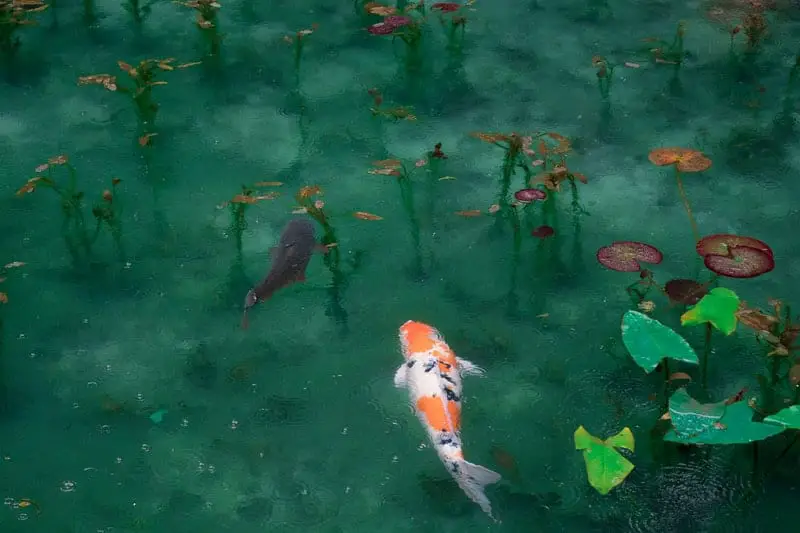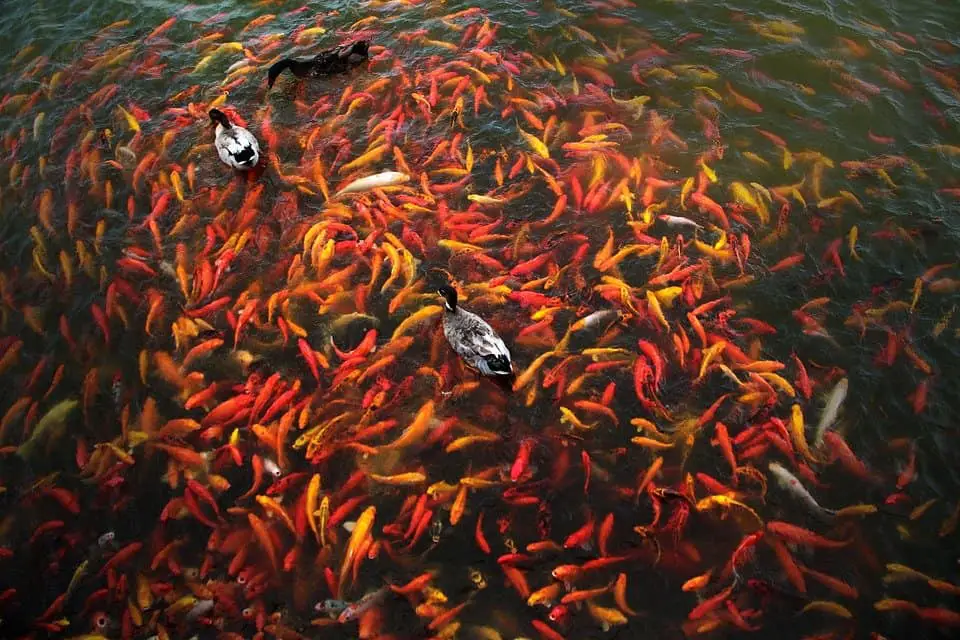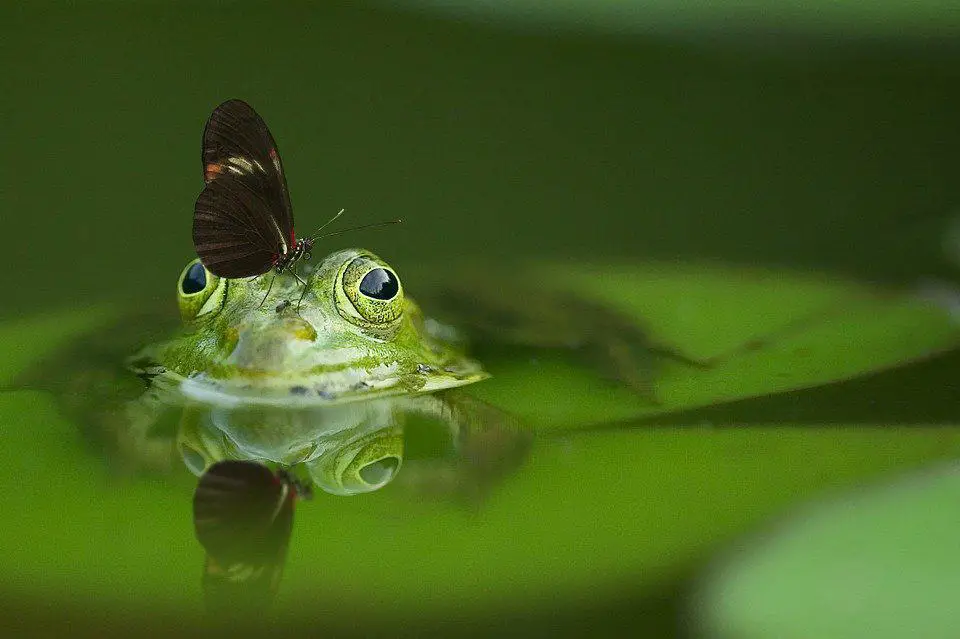Pond water ecology is the circle of life within your pond. Natural pond balance works, but most people do not have the patience to wait for nature to take its course. Many companies promote needless monthly chemical applications to maintain ponds. This chemical burden is entirely unnecessary and detrimental to your pond and the environment as a whole. Their job is to sell you products, pure and simple. They are not concerned for the health of your pond.
Table of Contents
It’s About Balance not Chemicals
When naturally balanced, the pond will eventually do very well on its own without help from us or chemicals.
With chemical use, it is a vicious cycle of killing algae with chemicals. The dead algae go to the bottom and create more nutrients for the next algae bloom as the chemicals wear off. Therefore, most natural bottomed retention ponds are a nightmare for their owners, as chemical treatments result in thick muck at the bottom and recurring algae blooms.
Pond ecology is the interaction of the life in the pond with the existing environment. A shallow pond that is nutrient-rich will be filled with algae and aquatic plants if exposed to the sun with little water flow through it. It has little animal life because of the low oxygen levels.
In contrast, a newly created spring-fed pond may have little life of any kind due to low temperatures and lack of food supply.
A healthy freshwater pond has the following layers:
- Bottom: There is very little sunlight or oxygen at the pond’s bottom. Decomposition occurs, and scavengers live here to feed on dead materials, such as water worms and grubs.
- Midwater: Fish are the main predators. Food is found on the surface of the pond or the pond bottom. Animals found here breathe through their gills or skin, for example, dragonflies, water fleas, or stickleback fish.
- Pond surface: Animals found here breathe through their lungs, gills, or skin. There is enough light and oxygen here. Animals found here include tadpoles, ducks, or midge larvae.
- Pond margin: Plants provide a sheltered habitat for insects or small animals, such as frogs. Oxygen and light are abundant, so plants such as marsh marigolds and other marginal aquatics can thrive.
- Above the pond’s surface: Insects such as dragonflies and birds such as kingfishers are prevalent here.
A Pond’s Life
A pond begins with mostly water, a few nutrients, and limited aquatic life. As the pond ages, the pond gathers nutrients. This process of enrichment is eutrophication. The addition of nutrients stimulates the growth of aquatic life. The organisms live, grow, then die.
Their remains and whatever else falls into the pond like leaves and debris decay in the pond. The nutrients in the plant debris are released back into the pond to keep the cycle going. With time, there will be an accumulation of material that resists decay. The pond will fill up, become a bog, and someday resemble dry land. This process of returning to dry land can occur in a decade or take centuries. It is the pond owners’ job to slow down this process as much as possible.
How to Slow Down the Process
Exclude the Basic Elements Needed to Make Aquatic Organisms
There are four essential elements needed to make aquatic organisms – carbon, nitrogen, oxygen, and phosphorous. These materials are required in abundance, along with other factors. To prevent the rapid aging of a pond (eutrophication), exclude the introduction of phosphorus and nitrogen. There are three methods helpful in slowing the aging process.
Buffers
We need to limit the nutrients coming into our pond, so animal access to streams or ponds should be restricted, and runoff controlled to limit phosphorus and nitrogen inputs from the waste.
Maintaining vegetation buffers in the areas where water must flow through to reach the pond is beneficial. Buffers slow down the water and filter it. Slow-moving water permits sediment to drop out of the water. Phosphorus attaches to soil particles, so sedimentation helps keep phosphorus out of the pond. Keeping sediment out of the pond prevents it from becoming shallow.
This directly contributes to the primary goal of keeping the pond from returning to dry land. A deeper pond will also be cooler. One of the general principles of biology is lower temperatures slow the growth of organisms, so the buffer area contributes to conditions that help slow the pond’s aging process.
Sedimentation
Providing a shallow pool at the pond’s inlet is another method of keeping sediment out of ponds. Water that passes through the pool will drop sediment into the pool on its way to the pond. The pool should be of a dimension enabling it to be easily cleaned with a backhoe from the shore. A sedimentation pool will help the pond in a similar way to buffer strips, but sediment ponds work well if the water’s inflow is too much and too concentrated for buffers.
Limit the Use of Fertilization

If it is possible to decrease fertilizer use on crops or turf grown in the pond’s watershed area, it will benefit. We can assume that anything applied to the ground anywhere within the watershed will eventually make its way to the pond.
Plants are never 100% efficient in their use of fertilizer elements. So, even at appropriate rates, applying fertilizers results in excess nitrogen getting into your pond. Also, any animals that use the watershed will leave waste, increasing nutrients in the pond.
Maintaining Ecological Balance

Ponds are most effective when there is a balanced and complete food web in place. This means that planktonic algae are present in sufficient quantity to feed zooplankton. The zooplankton then becomes food for aquatic insects and the smallest fish. These will then become prey for larger fish, finally to be food for heron, mink, raccoons, bears, or fishers.
Another part of maintaining ecological balance involves the higher plant community. Some pond owners are discouraged by too many plants in their pond. While a pond full of vegetation is not recommended, a nice balance of pond plants is required to maintain balance. From some pond owner’s viewpoint, a pond with vegetation along the shore is unsightly, so they often eliminate all pond plants and buffer plants and mow lawn right up to the shore.
The Clean Look?
Many like the “clean” look, so they kill plants with herbicide, fertilize their lawn right up to the waters’ edge, and then complain when their pond is overgrown with algae. This eventually leads them to dump chemicals in the pond to kill the algae and restore the “clean” look. Unfortunately, a pond like this is the opposite of clean. It is dead to most pond life and full of nutrients, just waiting for the chemicals to wear off to start another grand algae bloom.
Aquatic Plants

Aquatic plants can provide shade, places for small fish to hide, habitat for aquatic insects and animals, and food sources for some animals and fish. They are a vital part of the pond ecosystem, and they compete with the algae for nutrients, keeping it in check. It is about balance, not a clean look. A balanced pond is very clean and healthy.
There are certainly examples of too much vegetation in the pond. A pond completely covered with lotus or water lilies shade the pond so no other vegetation will grow under the water. There will not be enough light to grow planktonic algae, resulting in a pond that will be unproductive for anything besides lily growth.
Another example is the excessive growth of Watermeal or duckweed. When the entire pond surface is covered with these plants, the light is restricted, and the pond will contain little life beneath the surface. These plants virtually eliminate oxygenation of the water by maintaining the separation of the water surface from the atmosphere. As a result, the pond becomes deficient in oxygen to the extent that any fish present are killed.
You will notice that these are problems of extremes. Just like the extreme of too many plants results in negative consequences, so do too few plants.
Maintain Water Flow
A pond with continuous water flow will be more well-balanced than a pond with an intermittent flow. Water flow increases the water’s oxygenation and helps to reduce stratification. Also, new water entering the pond is important. While fresh water does indeed bring more nutrients, it also brings more oxygenation. A pond will lose significant water due to evaporation during the summer months. Ponds with sufficient inflow will stay full and refreshed, while the water levels of ponds without inflow will decline, resulting in lower oxygen levels in the water and less life.
Aeration
The pond’s overall health is dependent on oxygen in the pond water. Its value to the fish is obvious. Less obvious but essential is the pond’s ability to eliminate waste. The waste that happens in the pond includes waste from animal life such as geese and fish and the waste that falls into the pond like leaves, debris, and grass clippings. These waste materials can enter with stormwater runoff, wind, and along with animals and plants that die in the pond.
Bacteria and enzymes are needed to break down and consume all of this debris. Aerobic bacteria perform twenty times quicker than anaerobic bacteria to break down the waste. It can then be flushed out or is available to grow new life. The oxygenation of a pond is quite interesting. It occurs in two primary ways.
Photosynthesis
Algae and plants do photosynthesis during the day, with the wind adding oxygen at night. The oxygen that plants produce is released into the pond, helping maintain water oxygen levels. Conditions that prevent light and oxygen from entering the pond need to be monitored. A pond completely covered with watermeal can be in trouble in a hurry. All of the oxygen produced by the Watermeal is released into the atmosphere rather than into the pond.
Any part of the pond that is too dark for photosynthesis is likely oxygen-deficient unless the water column is circulated. Scientists use a Secchi disk to measure water transparency. The level at which they can no longer see the disk from the surface is the depth to which the pond will be oxygenated through photosynthesis. Anything below that level needs to be circulated to receive oxygen.
At the Surface of the Pond

Another method of getting oxygen into the pond water occurs by an oxygen exchange with the atmosphere at the pond’s surface. The rougher the surface is, the more rapid the exchange. Also, the more deficient the oxygen supply is in the water, the faster the exchange will occur.
This process is critical at night and essential for a pond with a heavy load of animals and plants. During the night, plants perform respiration rather than photosynthesis. The pond could be oxygen-deficient by morning if atmospheric aeration has been impeded by lack of wind or a covered surface.
We can significantly increase our ponds aeration by installing a bottom aeration system. Pumping air bubbles to the bottom of a pond will increase oxygen levels and circulate water, providing a better balance.
Pond Ecology in Winter
In the winter, as the water gets much colder, with ice covering the top of the pond for an extended period, the pond ecology changes.
Amphibians such as turtles, frogs, and fish have adaptive features that enable them to adjust to this less friendly environment. Their body temperature will drop with the water temperature, decreasing their energy requirements and respiration rate. Turtles and frogs burrow into the mud at the pond’s bottom and hibernate.
Ice prohibits oxygen entry into the pond through the surface; however, sunlight that gets through the ice will allow for some photosynthesis by the aquatic plants. An entirely snow-covered pond can quickly become depleted of oxygen, killing frogs, turtles, and fish.
A smaller, more shallow water body is more susceptible to this than a larger, deeper body of water simply due to the quantity of water. We can help this problem in our small ponds by providing bottom aeration, which will pump oxygen to the bottom of the pond all winter long to keep the water oxygenated. If we can’t aerate and if the ice is safe to walk on, we can clear lanes across the pond to remove some of the snow to let in the sunlight.
Changes to a Pond’s Ecosystem
Ecosystems are sensitive to change. Human or natural factors can alter the system’s living and non-living components.
Natural factors which cause adverse changes to the ecosystem can include:
- Disease
- Drought
- Fire
- Flood
- Heat
- Debris
- Ice and Snow cover
- Excessive plant growth (invasives)
- Excessive animal use (geese, ducks, etc.)
Human factors which cause adverse changes to the ecosystem can include:

- Adding too many fish
- Adding fish that carry disease
- Altering the drainage of the land, which can influence the quantity of water
- Altering the nutrient levels of the water with fertilizers, resulting in eutrophication.
- Chemical pond additives destroying the aquatic balance
- Mechanical sterilizers destroying the aquatic balance
- Allowing heavy debris loads into the pond
- Removing too many plants from a pond
- Electric current entering the pond
- Excessive livestock use of the pond
- Pumping from a pond for irrigation
Summary
Long pond life is best achieved by maintaining a healthy ecosystem. Your pond’s ecosystem is all about balance. When any one of the above factors gets out of balance, there will be consequences. Humans are the biggest disruptors of pond balance. When we see a pond with excessive algae growth, we shouldn’t ask, “what’s wrong with the pond?” we should ask, “what have we done to the pond to push it out of balance?”
By limiting the input of nutrients into the pond, taking nutrients out of the water with plants, adding bacteria to the water to aid decomposition, and providing aeration through continual water flow and mechanical aeration, we can do our part to get our ponds ecosystem balanced. Once balance has been achieved, the pond will care for itself with very little human input.

